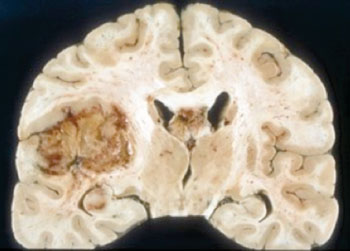Brain Tumor Chemotherapy Biomarkers Identified
|
By LabMedica International staff writers Posted on 24 Jul 2014 |

Image: Glioblastoma multiforme (GBM) (Photo courtesy of the University of California, San Diego School of Medicine).
Cancer researchers have identified a new biomarker that they believe can predict whether glioblastoma multiformes (GBMs), the most common and aggressive type of malignant brain tumor, will be susceptible to chemotherapy.
Previous work had shown that the activity of the enzyme 6-methylguanine DNA methyltransferase (MGMT) was a critical determinant of how GBM cells would respond to the chemotherapeutic drug temozolomide (TMZ).
The therapeutic benefit of TMZ depends on its ability to alkylate/methylate DNA, which most often occurs at the N-7 or O-6 positions of guanine residues. This methylation damages the DNA and triggers the death of tumor cells. However, some tumor cells are able to repair this type of DNA damage, and therefore diminish the therapeutic efficacy of TMZ, by expressing the protein O6-alkylguanine DNA alkyltransferase (AGT) encoded in humans by the O-6-methylguanine-DNA methyltransferase (MGMT) gene. In some tumors, epigenetic silencing of the MGMT gene prevents the synthesis of this enzyme, and as a consequence such tumors are more sensitive to killing by TMZ. Conversely, the presence of AGT protein in brain tumors predicts poor response to TMZ and these patients receive little benefit from chemotherapy with this drug.
Investigators at the University of California, San Diego School of Medicine (USA) had already found that MGMT was partially regulated by the microRNA (miRNA) miR-181d and other miRNAs. In the current study they sought to identify these other MGMT regulatory miRNAs and to determine whether any one in particular was the key regulator.
Towards this end, they performed a genome-wide screen to identify MGMT regulating miRNAs. Candidate miRNAs were further tested for inverse correlation with MGMT expression in clinical specimens.
The investigators identified 15 candidate miRNAs and characterized the top candidate, miR-603. They found that transfection of miR-603 suppressed MGMT mRNA/protein expression in vitro and in vivo; this effect was reversed by transfection with an antibody specific for miR-603. MiR-603 transfection enhanced the TMZ sensitivity of MGMT-expressing glioblastoma cell lines. Importantly, miR-603 mediated MGMT suppression and TMZ resistance were reversed by expression of an MGMT cDNA. In a collection of 74 clinical glioblastoma specimens, both miR-603 and miR-181d levels inversely correlated with MGMT expression. Moreover, a combined index of the two miRNAs better reflected MGMT expression than each individually.
“Every patient diagnosed with glioblastoma is treated with a chemotherapy called temozolomide. About 15% of these patients derive long-lasting benefit,” said senior author Dr. Clark C. Chen, professor of neurosurgery at the University of California, San Diego School of Medicine. “We need to identify which patients benefit from temozolomide and which another type of treatment. All therapies involve risk and the possibility of side-effects. Patients should not undergo therapies if there is no likelihood of benefit. We showed that a signature of the MGMT-regulating microRNAs predicted temozolomide response in a cohort of glioblastoma patients. Validation of these results should lead to diagnostic tools to enable us to determine which patients will benefit most from temozolomide therapy.”
The study was published in the June 30, 2014, issue of the journal Oncotarget.
Related Links:
University of California, San Diego School of Medicine
Previous work had shown that the activity of the enzyme 6-methylguanine DNA methyltransferase (MGMT) was a critical determinant of how GBM cells would respond to the chemotherapeutic drug temozolomide (TMZ).
The therapeutic benefit of TMZ depends on its ability to alkylate/methylate DNA, which most often occurs at the N-7 or O-6 positions of guanine residues. This methylation damages the DNA and triggers the death of tumor cells. However, some tumor cells are able to repair this type of DNA damage, and therefore diminish the therapeutic efficacy of TMZ, by expressing the protein O6-alkylguanine DNA alkyltransferase (AGT) encoded in humans by the O-6-methylguanine-DNA methyltransferase (MGMT) gene. In some tumors, epigenetic silencing of the MGMT gene prevents the synthesis of this enzyme, and as a consequence such tumors are more sensitive to killing by TMZ. Conversely, the presence of AGT protein in brain tumors predicts poor response to TMZ and these patients receive little benefit from chemotherapy with this drug.
Investigators at the University of California, San Diego School of Medicine (USA) had already found that MGMT was partially regulated by the microRNA (miRNA) miR-181d and other miRNAs. In the current study they sought to identify these other MGMT regulatory miRNAs and to determine whether any one in particular was the key regulator.
Towards this end, they performed a genome-wide screen to identify MGMT regulating miRNAs. Candidate miRNAs were further tested for inverse correlation with MGMT expression in clinical specimens.
The investigators identified 15 candidate miRNAs and characterized the top candidate, miR-603. They found that transfection of miR-603 suppressed MGMT mRNA/protein expression in vitro and in vivo; this effect was reversed by transfection with an antibody specific for miR-603. MiR-603 transfection enhanced the TMZ sensitivity of MGMT-expressing glioblastoma cell lines. Importantly, miR-603 mediated MGMT suppression and TMZ resistance were reversed by expression of an MGMT cDNA. In a collection of 74 clinical glioblastoma specimens, both miR-603 and miR-181d levels inversely correlated with MGMT expression. Moreover, a combined index of the two miRNAs better reflected MGMT expression than each individually.
“Every patient diagnosed with glioblastoma is treated with a chemotherapy called temozolomide. About 15% of these patients derive long-lasting benefit,” said senior author Dr. Clark C. Chen, professor of neurosurgery at the University of California, San Diego School of Medicine. “We need to identify which patients benefit from temozolomide and which another type of treatment. All therapies involve risk and the possibility of side-effects. Patients should not undergo therapies if there is no likelihood of benefit. We showed that a signature of the MGMT-regulating microRNAs predicted temozolomide response in a cohort of glioblastoma patients. Validation of these results should lead to diagnostic tools to enable us to determine which patients will benefit most from temozolomide therapy.”
The study was published in the June 30, 2014, issue of the journal Oncotarget.
Related Links:
University of California, San Diego School of Medicine
Latest Pathology News
- Genetics and AI Improve Diagnosis of Aortic Stenosis
- AI Tool Simultaneously Identifies Genetic Mutations and Disease Type
- Rapid Low-Cost Tests Can Prevent Child Deaths from Contaminated Medicinal Syrups
- Tumor Signals in Saliva and Blood Enable Non-Invasive Monitoring of Head and Neck Cancer
- Common Health Issues Can Influence New Blood Tests for Alzheimer’s Disease
- Blood Test Formula Identifies Chronic Liver Disease Patients with Higher Cancer Risk
- Tunable Cell-Sorting Device Holds Potential for Multiple Biomedical Applications
- AI Tool Outperforms Doctors in Spotting Blood Cell Abnormalities
- AI Tool Rapidly Analyzes Complex Cancer Images for Personalized Treatment
- Diagnostic Technology Performs Rapid Biofluid Analysis Using Single Droplet
- Novel Technology Tracks Hidden Cancer Cells Faster
- AI Tool Improves Breast Cancer Detection
- AI Tool Predicts Treatment Success in Rectal Cancer Patients
- Blood Test and Sputum Analysis Predict Acute COPD Exacerbation
- AI Tool to Transform Skin Cancer Detection with Near-Perfect Accuracy
- Unique Immune Signatures Distinguish Rare Autoimmune Condition from Multiple Sclerosis
Channels
Clinical Chemistry
view channel
Blood Test Could Predict and Identify Early Relapses in Myeloma Patients
Multiple myeloma is an incurable cancer of the bone marrow, and while many patients now live for more than a decade after diagnosis, a significant proportion relapse much earlier with poor outcomes.... Read more
Compact Raman Imaging System Detects Subtle Tumor Signals
Accurate cancer diagnosis often depends on labor-intensive tissue staining and expert pathological review, which can delay results and limit access to rapid screening. These conventional methods also make... Read moreMolecular Diagnostics
view channel
Multiplex Antibody Assay Could Transform Hepatitis B Immunity Testing
Hepatitis B remains a major global health challenge, yet immunity testing has historically been constrained by cost, operational complexity, and single-analyte approaches. Now, a multiplex antibody assay... Read more
Genetic Testing Improves Comprehensive Risk-Based Screening for Breast Cancer
Breast cancer screening has long relied on age-based guidelines, assuming similar risk across all women despite clear evidence that individual risk varies widely. This one-size-fits-all approach can lead... Read more
Urine Test Could Reveal Real Age and Life Span
Chronological age does not always reflect how quickly the body is aging, as biological age is shaped by genetics, stress, sleep, nutrition, and lifestyle factors such as smoking. A higher biological age... Read more
Genomic Test Identifies African Americans at Risk for Early Prostate Cancer Recurrence
Prostate cancer is one of the most commonly diagnosed cancers in men and a leading cause of cancer-related death, particularly in the United States. African American men face a disproportionately higher... Read moreHematology
view channel
MRD Tests Could Predict Survival in Leukemia Patients
Acute myeloid leukemia is an aggressive blood cancer that disrupts normal blood cell production and often relapses even after intensive treatment. Clinicians currently lack early, reliable markers to predict... Read more
Platelet Activity Blood Test in Middle Age Could Identify Early Alzheimer’s Risk
Early detection of Alzheimer’s disease remains one of the biggest unmet needs in neurology, particularly because the biological changes underlying the disorder begin decades before memory symptoms appear.... Read more
Microvesicles Measurement Could Detect Vascular Injury in Sickle Cell Disease Patients
Assessing disease severity in sickle cell disease (SCD) remains challenging, especially when trying to predict hemolysis, vascular injury, and risk of complications such as vaso-occlusive crises.... Read more
ADLM’s New Coagulation Testing Guidance to Improve Care for Patients on Blood Thinners
Direct oral anticoagulants (DOACs) are one of the most common types of blood thinners. Patients take them to prevent a host of complications that could arise from blood clotting, including stroke, deep... Read moreImmunology
view channel
Ultrasensitive Liquid Biopsy Demonstrates Efficacy in Predicting Immunotherapy Response
Immunotherapy has transformed cancer treatment, but only a small proportion of patients experience lasting benefit, with response rates often remaining between 10% and 20%. Clinicians currently lack reliable... Read more
Blood Test Could Identify Colon Cancer Patients to Benefit from NSAIDs
Colon cancer remains a major cause of cancer-related illness, with many patients facing relapse even after surgery and chemotherapy. Up to 40% of people with stage III disease experience recurrence, highlighting... Read moreMicrobiology
view channel
New UTI Diagnosis Method Delivers Antibiotic Resistance Results 24 Hours Earlier
Urinary tract infections affect around 152 million people every year, making them one of the most common bacterial infections worldwide. In routine medical practice, diagnosis often relies on rapid urine... Read more
Breakthroughs in Microbial Analysis to Enhance Disease Prediction
Microorganisms shape human health, ecosystems, and the planet’s climate, yet identifying them and understanding how they are related remains a major scientific challenge. Even with modern DNA sequencing,... Read moreTechnology
view channel
Pioneering Blood Test Detects Lung Cancer Using Infrared Imaging
Detecting cancer early and tracking how it responds to treatment remains a major challenge, particularly when cancer cells are present in extremely low numbers in the bloodstream. Circulating tumor cells... Read more
AI Predicts Colorectal Cancer Survival Using Clinical and Molecular Features
Colorectal cancer is one of the most common and deadly cancers worldwide, and accurately predicting patient survival remains a major clinical challenge. Traditional prognostic tools often rely on either... Read moreIndustry
view channel
BD and Penn Institute Collaborate to Advance Immunotherapy through Flow Cytometry
BD (Becton, Dickinson and Company, Franklin Lakes, NJ, USA) has entered into a strategic collaboration with the Institute for Immunology and Immune Health (I3H, Philadelphia, PA, USA) at the University... Read more


















